Time : September 10, 2024
Linear motion system:
Metal linear bearings are a kind of linear motion system produced at low cost, which are used for unlimited stroke and cylindrical shaft. They are widely used in sliding parts of industrial machinery such as precision machine tools, textile machinery, food packaging machinery, printing machinery, etc.
Introduction:
Linear bearings are a kind of linear motion system, which are used for linear stroke and cylindrical shaft. Since the load-bearing ball is in point contact with the bearing outer sleeve, the steel ball rolls with the minimum friction resistance, so the linear bearing has low friction and is relatively stable. It does not change with the bearing speed, and can obtain smooth linear motion with high sensitivity and high precision. Linear bearing consumption also has its limitations. The most important thing is that the impact load capacity of the bearing is poor, and the load-bearing capacity is also poor. Secondly, the linear bearing has large vibration and noise when moving at high speed. The automatic selection of linear bearings is included. Linear bearings are widely used in sliding parts of industrial machinery such as precision machine tools, textile machinery, food packaging machinery, printing machinery, etc.
Since the load-bearing ball is in point contact with the bearing, the load is small. The steel ball rotates with very small friction resistance, so that high-precision smooth motion can be obtained.
Plastic linear bearings are a kind of linear motion system with self-lubricating characteristics. The biggest difference between them and metal linear bearings is that metal linear bearings are rolling friction, and the bearing and the cylindrical shaft are in point contact, so this type is suitable for low-load high-speed motion; while plastic linear bearings are sliding friction, and the bearing and the cylindrical shaft are in surface contact, so this type is suitable for high-load medium- and low-speed motion.
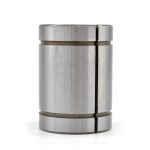
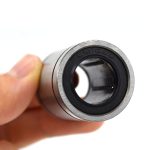
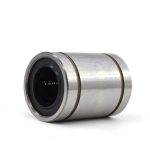
Features:
Linear bearings are used in conjunction with hardened linear drive shafts. A system for infinite linear motion. Because the load ball and the hardened drive shaft are in point contact, the allowable load is small, but during linear motion, the friction resistance is minimal, the precision is high, and the motion is fast.
Classification:
(1) Standard type, clearance adjustment type linear bearings, open type linear bearings, extended type linear bearings, general type linear bearings
(2) Flange type linear bearings can be divided into: round flange type, square flange type, elliptical flange type, guide round flange type, guide square flange type, guide elliptical flange type, and extended round flange type.
According to specifications:
It is divided into two series, namely LM and LME series. Its code LM series is used in Asia, Southeast Asian countries, Japan, South Korea, China, etc. Based on metric dimensions, the outer diameter tolerance of the linear shaft is generally h7. The LME series is mostly used in Europe, the United States, Germany, Italy and other regions. Based on imperial dimensions, there are also metric dimensions, and the outer diameter tolerance of the linear shaft is generally g6. The structural features of the two series are roughly the same except for the different sizes and aperture tolerances.
According to shape:
1. Straight type (shaped like a cylinder, generally installed with a retaining ring, used in occasions with smaller installation dimensions)
2. Flange type (with a mounting flange at the end or in the middle, which can be installed with screws. Flanges are generally divided into three types: round, square and trimmed)
3. Open type (shaped like a straight cylinder, with an axial slit on the surface, used in occasions where clearance adjustment is required, divided into two types: large opening and small opening)
According to performance:
1. Ordinary type (for general performance requirements)
2. Super type (for occasions with long life and high load performance requirements)
Use:
Linear bearings are increasingly widely used in precision equipment or special machinery industries such as electronic equipment, food machinery, packaging machinery, medical machinery, printing machinery, textile machinery, machinery, instruments, robots, tool machinery, CNC machine tools, automobiles and digital three-dimensional coordinate measuring equipment.
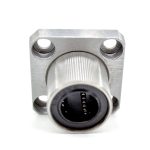
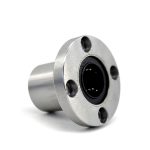
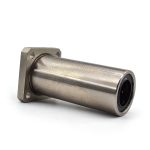

Clearance:
The inner and outer diameters of linear bearing adjustment type and open type bearings are measured before cutting. There will be some elastic deformation after cutting. The matching clearance should be installed in the bearing seat for measurement (similar to the situation of steel retainer bearings and KH bearings). The adjustment direction of the bearing seat with adjustable clearance should be perpendicular to the direction of the bearing cut to ensure uniform clearance. The structural characteristics of linear bearings cannot be rotated, and good guidance is required. Therefore, linear bearings are generally used in combination of two shafts + four sets of bearings or two shafts + two sets of extended bearings. The two shafts must be installed straight. After the entire combination is assembled, the transmission mechanism can only be installed by hand push and pull flexibly without obstruction. The transmission power must be sufficient to overcome the friction resistance of the bearing. The friction resistance of the linear bearing is approximately one thousandth of the working load.
Maintenance:
Maintenance of metal linear bearings: Lubrication and friction: Anti-corrosion oil is injected into the linear bearing. If grease is used for lubrication, first use kerosene or organic solvent to remove the anti-corrosion oil, and then add grease after air drying (it is recommended to use lithium soap grease with viscosity mark N0.2.) If oil is used for lubrication, it is not necessary to remove the anti-corrosion oil. According to temperature changes, ISO viscosity grade VG15-100 lubricating oil can be selected. Shaft lubrication can be supplied from the oil supply pipe or from the oil hole on the outer bearing seat. Oil lubrication is not suitable for non-porous bearings with seals because the seals will scrape away the lubricating oil.